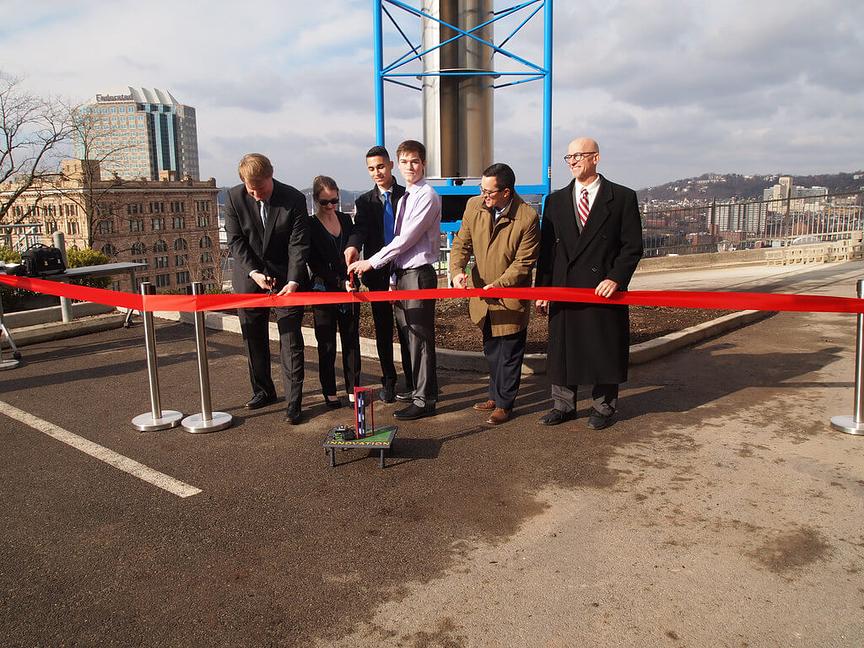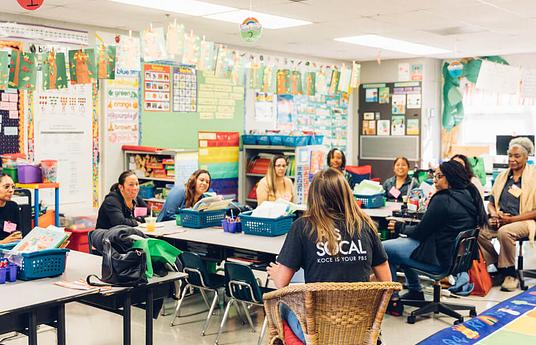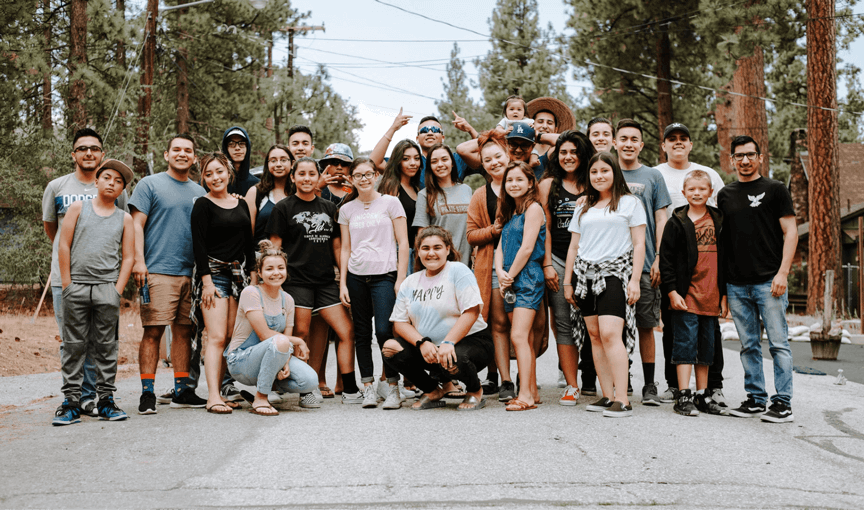Design Challenges are opportunities for students to solve real world problems working in teams as consultants. Students need to learn how to think about the needs of a client (empathize) through a real-world business document, a Request for Proposal (RfP), pose questions to understand the problem (define), develop possible strategies (ideate), create physical models and verbal hypotheses to solve the problem (prototype), and then present their proposed solutions to a real world audience (test). This process that taps into the Design Thinking process comes together through a series of unique problems identified by the Energy Innovation Center (EIC) of Pittsburgh. Each Design Challenge while unique follows a similar pattern that enlists experts, a client team, and student consulting teams from multiple schools. Key to all of the Design Challenges is the opportunity for students from different schools to work collaboratively as consultants to solve a real world problem at the Energy Innovation Center of Pittsburgh or the Parkway West Career and Technology Center.
The client identifies the problem for the RFP. The client shares the problem with the consulting teams as part of an introductory meeting or entry event. The client addresses questions and issues raised by the consulting teams (who share their issues/questions with the Design Challenge Coordinator). The client responds to the final proposal based on the considerations identified in the RFP.
The teacher should really be a facilitator who lets the student consultants grapple with the Design Challenge. The challenge has ambiguities, but there are key issues outlined in the RFP. The teacher should make sure that the student consultants address the key issues. The teacher should also work with the group on presentation skills. The teacher can arrange for outside resources to help with the challenge, e.g. an architect. The teacher is the point of contact for all questions and issues with the Design Challenge Coordinator.
The experts are professionals who address questions from the consulting teams and then provide the evaluative feedback to the student consulting teams at the Public Exhibition - the presentation by the student consulting team. The experts work with the student consultants at the kickoff, a midpoint session, and the final public presentation. The experts ask key questions to guide the student consultants to successfully address the RFP for the Design Challenge. The experts provide feedback at each stage helping to shape the Design Challenge.
The Design Challenges have ranged from developing the parameters for the construction of a wind turbine at the EIC to creating food menu items for a proposed cafe at the EIC. The wind turbine project brought together an expert team from Windstax, a manufacturer of windmills, Epiphany Industry, a company that provides funding for sustainable energy projects, and the client team from the EIC. The student teams worked collaboratively to develop a working prototype of the wind turbine, design a off-the-grid power solution to store the energy generated by the wind turbine, and develop an educational plan to explain the process to visitors at the EIC. The project came to fruition with a ribbon-cutting ceremony that included public officials from city and county governments with the actual construction of a 40 foot Windstax turbine based on the student prototype and recommendations.
The food menu item represents a very different challenge, but with a similar pattern. In this Design Challenge all students generated their ideas for nutritious appetizers, drinks, entrees, and desserts for a proposed cafe at the EIC. Experts from Penn State University, the Community Kitchen, and the University of Pittsburgh Medical Center provide feedback to the student consultants. As part of their investigation the students pitch their ideas at a midpoint event. The experts and clients rate the best items using a visualize the vote process and then the best ideas take shape in the culinary kitchen at the Parkway West Career and Technology Center. The other student consultants work with the culinary team to identify the nutritional value of each food item and to develop a marketing plan for the use of the foods at the EIC Cafe. At the final presentation all the experts, client team, and the student consultants sample the food items and review the marketing plan for the project. All three student consulting teams and guests celebrate over a luncheon prepared by the culinary students at Parkway West.
Design Challenge topics beginning in 2016 include:
- Renovation of Energy Innovation Center Facade
- Design of Stormwater Management System for Letsche Middle School facility, (part of the EIC campus)
- Energy Innovation Center Theater Renovation
- Energy Innovation Center Café Design, Including Food and Drink Offerings and Collaborations
- Sustainable and Edible Gardens Design for Schools Collaborating with Parkway West CTC and Energy Innovation Center Cafés
- “Green Acres” Master Plan Design of Parkway West CTC Rural Green Space to Create a “Sustainable Community” to Collaborate with Energy Innovation Center Urban Campus
- Windmill & Sustainable Energy Design Challenge for the EIC
- Innovative Food Product Design Challenge for the EIC
- Ideas for Tomorrow Displayed Today (Related to LEED Certification Status)
- Rebranding Career Opportunities
- Bedford Avenue Façade Lighting Plan for the EIC
- Rebranding Careers Redux
- Creating a Healthy and Nourishing Food Kit for the EIC
- Preparing for the Unknown - Developing a Safety Plan for the EIC
The Energy Innovation Center (EIC) is a Pittsburgh based, not-for-profit organization with a mission focused on sustainability and workforce development. The physical building has been renovated meeting LEED standards. The building now houses major university research and training facilities, startup businesses, non-profit groups, and classrooms for workforce training by the major trade industries in the Pittsburgh region.
The Parkwest Consortium of Schools includes twelve school districts from the western suburbs of the city of Pittsburgh. Most of the Design Challenges include two of the member schools and a third team from the Parkway West Career and Technology Center, a workforce development center offering a wide-variety of technical classes for the twelve member school districts. The schools have diverse populations. The participating schools select students to join the Design Challenges based on each school's needs. Some schools focus on a particular class, an environmental science course, for example, while others have created project-based learning classes where students work on a variety of activities like Design Challenges.
The Design Challenges include a wide variety of experts who have come from corporate, civic, and university partners: the city of Pittsburgh Mayor's office, Penn State University, Chatham University, Community College of Allegheny County, University of Pittsburgh Medical Center, Duquesne Light, Windstax, Redfish Group, Epiphany Solar, WQED-TV, Food Rescue 412, SimTable, Pittsburgh Technology Council, and the Community Kitchen. The experts meet with the student consultants beginning with the Kickoff at the EIC. At a midpoint session the experts interact with the student consultants to help shape the initial set of ideas or strategies to address the real world problem identified in a Request for Proposal (RFP). The experts then reconvene for a public presentation by the student consultants where the client team joins the experts to listen and evaluate the final recommendations by the student consulting teams.
There are some key underlying processes and elements:
- Students and teachers should have choices on how they’ll respond to the Challenge.
- Experts should be available to help introduce the challenge, frame the challenge, and evaluate the student response to the challenge.
- Students need to learn how to work in collaborative teams and use creative strategies to solve problems.
- Students need to communicate their findings to a client by making creative products that address the costs for the implementation of the solution.
- Every student needs to play an active role at each key stage - kick-off, midpoint, and final presentation.
- Each challenge should be a real problem that students have some interest in solving.
- It’s critical to document the process and have data to evaluate the success of the challenge.
The Design Challenges follow a similar pattern that includes:
- Week 1: Frame the Problem
- Week 2: Kick-off - Understand the Problem through a Request for Proposal (RFP)
- Weeks 3-5: Conduct research and interviews with key experts / Work on the problem at individual sites
- Week 5-6: Midpoint - Develop a collaborative solution
- Weeks 7-9 Refine the proposed solution at individual sites
- Week 10: Final Presentation - Rehearse the presentation/ Present proposal to address RFP
All of the Design Challenges are evaluated based on interviews with experts and the client team as well as surveys submitted by the student consultants, facilitators, and experts. The results of the Design Challenges have met the anticipated outcomes. For 2017-2018 for example:
- 93% Relevant and Useful
- 93% Good to work in teams
- 89% Use strategies in everyday life
- 86% Time to complete
- 86% Excellent quality
- 86% Recommend to others
- 86% Help with future job opportunities



